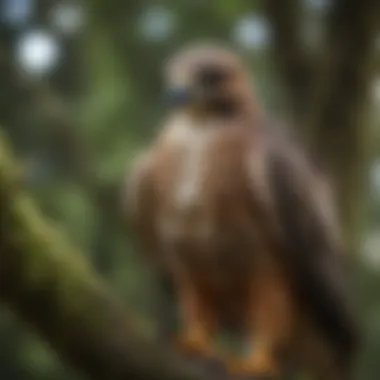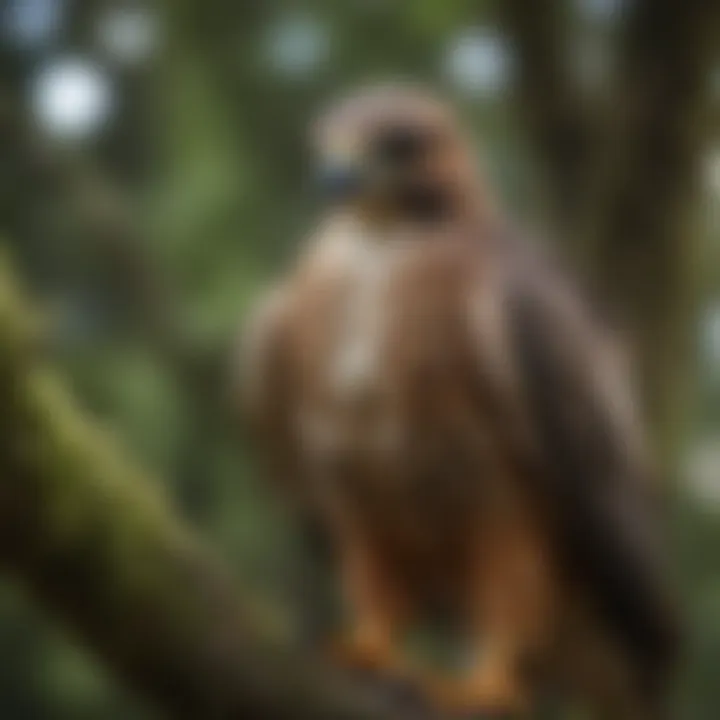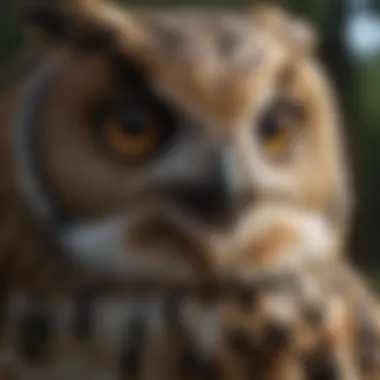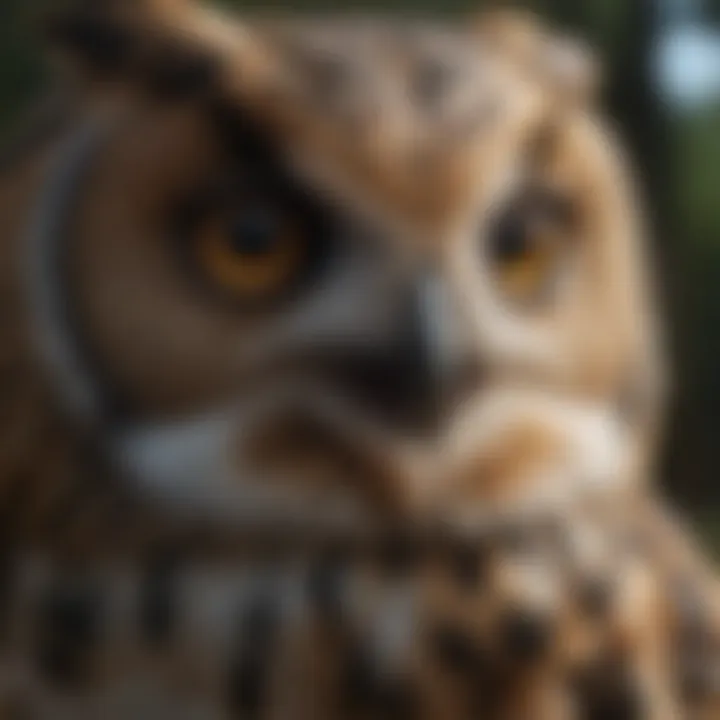Understanding Raptors: Identification and Characteristics


Intro
Raptors represent an intriguing subset of birds, well-regarded for their predatory expertise and distinct physical attributes. Characterized by strong talons and keen eyesight, these avian creatures play crucial roles in their ecosystems, serving as apex predators and indicators of environmental health. Understanding raptors involves more than identifying species; it encompasses an appreciation of their behavior, habitats, and the conservation challenges they face today.
As this article moves forward, it will delve deeply into the identification traits unique to raptors, exploring general characteristics, typical habitats, and significant conservation efforts. The insights shared here aim to inform both seasoned bird watchers and those who are simply intrigued by the rich diversity of avian life.
Care Tips
Raptor care is essential for those involved in rehabilitation or conservation efforts. It's critical that care routines cater to their specific needs as birds of prey.
Daily Care Routines
Daily routines should include appropriate feeding schedules, maintenance of their environment, and observation of their behaviors. Ensuring they are fed a diet suited to their species is paramount. Raptors typically require whole prey items like rodents, which provide essential nutrients.
Cage Setup and Maintenance
Proper setup of aviaries is vital. Raptors require space to fly, suitable perches, and areas for hiding to feel secure. Regular maintenance checks will help prevent potential health risks and ensure their environment remains stimulating and safe.
Hygiene and Cleaning Practices
Maintaining hygiene is crucial in raptor care. This includes regular cleaning of perches and feeding areas to prevent buildup of waste that could harbor pathogens.
Seasonal Care Adjustments
Adjustments in care based on seasonal changes are also important. During breeding season, specific attention to diet and nesting needs must be provided. Similarly, when temperatures drop, additional warmth and protection from harsh weather become essential.
Behavioral Insights
Understanding raptor behavior is a key component of care and rehabilitation. These birds have complex social structures and communication methods that may vary by species.
Understanding Bird Body Language
Learning raptor body language can aid in recognizing stress or discomfort. For example, a raptor that raises its feathers or displays aggressive posture may feel threatened.
Common Behavioral Issues and Solutions
Behavioral issues like aggression or refusal to eat can be addressed through careful observation and understanding of their needs. For instance, a raptor refusing to eat may need a change of prey type or encouragement through interactive feeding.
Positive Reinforcement Techniques
Positive reinforcement is critical in any training process. Providing rewards for desired behaviors can promote better interaction between the caregiver and the bird.
Social Interaction Needs
Many raptors are solitary by nature, but they can benefit from social interaction with humans. Carefully scheduled interaction times will help them become accustomed to human presence and reduce stress in captive scenarios.
Nutrition Guides
Tailored nutrition is crucial to maintaining health and vigor in raptors. Understanding dietary needs can vastly improve their well-being.
Essential Diet Components
A variety of prey such as small mammals, birds, and insects constitute a balanced diet for raptors. Different species require varying proportions and types of protein sources.
Safe and Toxic Foods
Bird owners must be aware of foods that are harmful to these birds. Foods like chocolate and avocados can be toxic and should always be avoided.
Supplements and Treats
In some cases, supplements might be necessary to ensure nutritional adequacy. Providing treats can also enhance the feeding experience for raptors, making it more enriching.
Feeding Strategies for Different Species
Feeding strategies must align with different raptor species. For instance, diurnal raptors may have different needs from their nocturnal counterparts.
Wellness and Health
Regular health assessments are vital for ensuring the overall well-being of raptors in any care setting.
Routine Health Checkups
Regular checkups help in catching potential health issues early on. A veterinarian familiar with raptors can provide invaluable guidance.
Identifying Symptoms of Illness
Being observant of behavioral changes or physical symptoms like lethargy or changes in feeding habits can indicate illness.
Preventative Care and Vaccinations
Preventative measures, including vaccinations and routine care practices, should be emphasized to keep these birds healthy.
Mental and Emotional Well-being
Raptors require mental stimulation and emotional enrichment. Providing varied toys or interaction can help keep them engaged and prevent boredom.
Enriching Activities
Engaging raptors in activities can significantly improve their quality of life and encourage natural behaviors.
Toys and Playtime Ideas
Offering toys that stimulate physical and mental activity caters to their hunting instincts, enhancing their well-being.


Training and Tricks
Training sessions that incorporate simple commands can encourage interaction and strengthen bonds with caregivers.
Outdoor Activities and Interaction
Supervised outings can promote exercise and natural hunting behaviors, echoing the activities they would partake in the wild.
DIY Projects for Mental Stimulation
Creating homemade foraging puzzles can keep raptors mentally stimulated and satisfied, mirroring their natural hunting challenges.
In order to sustain healthy raptor populations, understanding and addressing their unique needs is essential. The more we learn, the better equipped we become to support these magnificent birds in their natural habitats and beyond.
Defining Raptors
Understanding the term raptor is crucial to fully appreciate the diverse avian species within this group. Raptors, commonly known as birds of prey, are characterized by their keen predatory skills and unique physical adaptations. This section aims to elucidate the definition and characteristics of raptors, setting the stage for a deeper exploration of their roles in ecosystems and their significance in various cultural contexts.
The Term 'Raptor'
The term raptor is derived from the Latin word rapere, meaning "to seize" or "to take by force." This etymology reflects the predatory nature of these birds. Raptors are often categorized into two main types: diurnal and nocturnal. Diurnal raptors, such as eagles and hawks, are active during the day, while owls dominate the night skies. Understanding this classification helps in identifying the specific behaviors and habitats associated with different species.
Characteristics of Raptors
Raptors possess a distinct set of characteristics that enable them to hunt efficiently. These traits are not only fascinating but also highlight the evolutionary adaptations that have taken place over time.
Sharp talons and beaks
Sharp talons and beaks are among the most defining features of raptors. The talons, used for gripping and killing prey, are strong and curved, allowing these birds to catch and hold onto their food securely. The beaks are also sharply pointed, designed for tearing flesh. This adaptation is essential, as it enables raptors to process their food quickly and efficiently, minimizing the risk of losing it to competitors or scavengers.
Excellent vision
Excellent vision sets raptors apart from many other birds. They possess a high density of photoreceptors in their retinas, granting them exceptional visual acuity. This capability allows them to spot small animals from great distances, an essential skill for hunting. The unique placement of their eyes, often facing forward, provides a wide field of view and depth perception. In the context of this article, understanding how eyesight functions for raptors underlines their effectiveness as hunters.
Strong flight capabilities
Strong flight capabilities are another hallmark of raptors. Their wings are large and powerful, which aids in soaring effortlessly through the skies. This ability to glide allows them to travel vast distances without expending much energy. This section emphasizes the importance of such flight adaptations in their hunting strategies and overall survival in the wild. Raptors can utilize thermal currents to ascend without flapping their wings, making them efficient hunters in open environments.
"Raptors represent a remarkable convergence of evolutionary traits, allowing them to dominate their ecological niches."
The characteristics outlined above not only help define what raptors are but also serve as a foundation for recognizing their roles in ecosystems. With sharp talons and beaks, excellent vision, and strong flight capabilities, raptors exemplify the adaptations necessary for survival in a competitive landscape.
Major Types of Raptors
The classification of raptors is essential for understanding their diverse behaviors, adaptations, and roles in ecosystems. Differentiating between diurnal and nocturnal raptors allows enthusiasts and ornithologists to appreciate their unique characteristics and hunting techniques. Each type of raptor has distinct hunting habits that influence their physical and behavioral traits, ultimately shaping the ecosystems they inhabit.
Diurnal Raptors
Diurnal raptors are birds that primarily hunt during the day. Their vision, speed, and hunting strategies differentiate them from their nocturnal counterparts. Among diurnal raptors, eagles, hawks, and falcons stand out due to their adaptability and efficiency as predators. These birds exhibit remarkable talents, contributing significantly to their environments.
Eagles
Eagles are often seen as the kings of the skies, with outstanding hunting skills. Their keen eyesight is a defining characteristic, allowing them to spot prey from great heights. This trait makes them very effective hunters. Eagles thrive in various environments, which makes them a popular choice for study in this article.
One unique feature of eagles is their massive wingspan. A large wingspan provides them with the ability to soar effortlessly while searching for food. This can be advantageous in analyzing their migration patterns and territorial behaviors.
Hawks
Hawks, known for their agility, are skilled hunters adept at pursuing fast-moving prey. Their strong and compact bodies allow for rapid turns and acceleration, making them successful in both open fields and woodlands. This agility is one reason why they are a beneficial subject in understanding hunting strategies of diurnal raptors.
Hawks commonly use a technique called "kiting," where they hover in mid-air before diving for prey. This ability to remain stationary in strong winds while observing potential meals gives them a significant edge.
Falcons
Falcons are renowned for their incredible speed, especially during hunting dives, known as stoops. They possess a specialized tear duct that aids in clearing their vision while flying at high speeds. This characterstic makes them invaluable for discussions on adaptation and efficiency in the raptor family.
Falcons are also highly adaptable, being able to thrive in urban environments as well as in the wild. Their unique ability to hunt and reside in varied habitats is essential when considering the adaptability of raptors in general.
Nocturnal Raptors
Nocturnal raptors, primarily owls, are specifically adapted for hunting at night. These birds have unique physical features that optimize their night-time hunting capabilities. Their silent flight and exceptional hearing make them effective predators in low-light conditions. Understanding these adaptations and behaviors is crucial for comprehending the full spectrum of raptor biology.
Owls
Owls are often associated with wisdom, but their hunting prowess is equally impressive. With large, forward-facing eyes, they possess excellent depth perception. This allows them to locate and engage prey even in darkness, which is their key characteristic. Such abilities make them a very interesting group for analysis in this article.
A unique feature of owls is their ability to rotate their heads up to 270 degrees. This physical adaptation aids in their ability to scan their surroundings without moving their bodies, enhancing their stealth while hunting. Consequently, owls provide valuable insights into nocturnal predation and adaptation in the raptor category.
Notable Species of Raptors
Raptors are an essential part of our ecosystems. They play crucial roles, from controlling prey populations to maintaining the balance in nature. In this section, we shall focus on specific notable species that illustrate the diversity within this group. By examining their characteristics, habitats, and behaviors, we gain a deeper appreciation of these magnificent birds.
Bald Eagle
The Bald Eagle, Haliaeetus leucocephalus, represents a powerful symbol of freedom and strength in North America. It is characterized by its striking white head and tail juxtaposed against a dark brown body. This species prefers large bodies of open water, such as lakes and rivers, which provide abundant fish supplies.
Bald Eagles are known for their impressive hunting skills. They can spot prey from great heights, thanks to their exceptional vision. Once they spot a fish, they dive with precision, using their strong talons to grasp their meal. During the breeding season, they build large nests that can be reused for many years.
Their populations faced drastic declines in the 20th century due to habitat loss and pesticide use, particularly DDT. However, conservation efforts have led to remarkable recoveries. Today, the Bald Eagle serves as a reminder of the resilience of raptors and the importance of preservation efforts.
Peregrine Falcon
The Peregrine Falcon, Falco peregrinus, hold the title of the fastest bird in the world, reaching speeds over 240 mph during its hunting stoop (high-speed dive). They are easily recognized by their blue-gray plumage and distinctive black head. Their hunting prowess lies in aerial agility that allows them to chase down prey, often other birds.


Peregrine Falcons can adapt to varied environments, from urban skyscrapers to wild cliffs. In urban settings, they often nest on buildings, using ledges as suitable nesting sites. Their presence in cities has created unique challenges and opportunities for education about raptors and environmental health.
Historically, this species suffered significant population declines due to chemical pollutants. The ban on harmful pesticides has aided their recovery. The Peregrine Falcon exemplifies adaptation and survival amid human expansion.
Great Horned Owl
The Great Horned Owl, Bubo virginianus, is one of the most recognizable owls in North America, identifiable by its tufted ears and striking yellow eyes. This species is highly versatile, inhabiting various environments such as forests, deserts, and urban areas. Great Horned Owls are primarily nocturnal hunters, using their silent flight to sneak up on prey, which includes rodents, birds, and even small mammals.
Their nesting habits are also notable. They often take over nests built by other birds rather than constructing their own. This behavior reflects their adaptability in using available resources in their habitat. The vocalizations of the Great Horned Owl, which include deep hoots, resonate through the night, marking their presence within ecosystems.
Conservation efforts focus on maintaining habitats and understanding their role within food chains. Educating the public about these prominent predators enhances their appreciation and supports conservation initiatives.
Understanding the distinct characteristics of these notable species is crucial. It informs conservation strategies and encourages awareness of the ecological significance of raptors within their habitats.
Raptor Habitats
Understanding raptor habitats is essential for those interested in avian species. Raptors, as apex predators, depend heavily on their habitats to thrive. A habitat influences their hunting strategies, reproductive success, and overall survival. Different environments offer various resources such as prey availability and nesting sites. This section delves into specific habitats like forests, open fields, and mountains, illustrating how these environments cater to the distinct needs of raptors. Recognizing these habitats helps bird enthusiasts appreciate the intricate relationships between raptors and their ecosystems.
Typical Environments
Forests
Forests offer a unique environment conducive to various raptor species. Wooded areas provide abundant perches for hunting and nesting. Hawks, for instance, find refuge in tree canopies, where they can scan for potential prey. The dense foliage can also act as a visual barrier, helping raptors approach prey without detection. However, the complexity of forests can also pose challenges, such as navigating through thick branches, which may limit flight speed in tight spaces. Therefore, forests represent a beneficial choice for many raptors, especially those that rely on stealth.
Open fields
Open fields present a contrasting habitat, favored by raptors like the American kestrel. The wide expanse allows for prolonged sightlines, making it easier for them to spot small mammals and insects. With less obstruction, raptors can also use their speed during aerial pursuits. One notable feature of open fields is the abundance of grass and small shrubs, which can generate rich prey habitats. However, the lack of cover might make it harder for raptors to hunt undetected. Open fields serve as valuable hunting grounds, emphasizing the flexibility of various raptor species.
Mountains
Mountainous regions provide raptors with unique benefits tied to altitude. Species such as the golden eagle thrive in these habitats, where they can soar high above the terrain, taking advantage of thermal currents. Mountains often host steep cliffs and crags, serving as nesting sites that offer protection from predators. The expansive views grant these raptors a broader hunting range. Despite these advantages, the rugged terrain can make access to prey more challenging. Therefore, mountains illustrate both the benefits and limitations faced by raptors in specialized habitats.
Adaptations to Habitat
Raptors have developed remarkable adaptations enabling them to survive in diverse habitats. Their keen eyesight aids in detecting prey from afar, while sharp talons allow for effective capture. Additionally, raptors have strong wings designed for agility and speed, essential in varied landscapes. Specific adaptations may vary depending on habitat type, but the core adaptations are critical to their survival. Understanding these adaptations enhances our appreciation of raptors' resilience and their role within ecosystems.
Hunting Techniques of Raptors
Hunting techniques of raptors are vital for understanding how these birds thrive in their environments. Each method reflects the unique adaptations of species to their habitats and prey preferences. Learning about these techniques is critical, not just for ornithologists but also for bird enthusiasts who wish to appreciate the complexity of raptor behavior. The strategies employed by these birds highlight their skills in survival and their significant role in maintaining ecological balance.
Stalking and Ambush
Stalking and ambush methods are employed primarily by ground or tree-nesting raptors. This technique emphasizes stealth and patience over speed. Raptors such as the Red-tailed Hawk often perch quietly, observing the ground for movement. They blend into the environment, relying on their feathers' camouflage to approach prey without detection.
Some key features of stalking include:
- Quiet Movements: Raptors remain quiet to avoid alerting prey. Each step is calculated, often moving slowly to maintain stealth.
- Heightened Vision: Their exceptional eyesight allows them to identify prey even from significant distances, ensuring that no movement goes unnoticed.
- Calculating Distance: Raptors often gauge the distance of their prey and decide on the best moment to attack for maximum effectiveness.
"The successful ambush demands not only patience but also an intimate understanding of the prey's behavior."
This technique is particularly effective during the breeding season when energy is needed for feeding young. By honing these methods, raptors can secure food efficiently.
Aerial Hunting Strategies
Aerial hunting strategies are another hallmark of raptor predation. Many species, particularly hawks and eagles, utilize the skies to hunt. This technique offers a unique advantage, allowing them to survey large areas at once.
The core elements involved in aerial hunting include:
- Soaring and Gliding: Raptors can soar to great heights, often using thermals to sustain energy. This enables them to cover extensive areas without tiring quickly.
- Diving Attacks: Once prey is spotted, these birds may perform a rapid dive, using gravity to enhance their speed. This can lead to successful captures.
- Coordination and Precision: Working alone or in pairs, raptors exhibit remarkable coordination when hunting. They can adjust their approach based on their environment and the type of prey they are pursuing.
The efficiency of these aerial techniques reflects the evolutionary adaptations of raptors to become proficient hunters. Birds like the Bald Eagle or the Peregrine Falcon are prime examples of species that excel in aerial hunting, showcasing the remarkable prowess of raptors in their natural habitat.
In summary, the hunting techniques employed by raptors are a testament to their physical capabilities and their evolutionary journey. Each method and strategy reveals the complexities of predator-prey dynamics and provides insight into the ecological roles these birds play.
Reproduction and Nesting Behaviors
Reproduction and nesting behaviors are vital topics to explore in understanding raptors. These elements not only define how raptors propagate their species but also illustrate their adaptations to various environments. Moreover, studying these behaviors provides insights into the challenges raptors face in an ever-changing world. As predators, raptors have specific reproductive needs and nesting habits, which ultimately impact the survival of their young.
Mating Rituals
Mating rituals among raptors are often elaborate and can vary significantly between species. These displays are essential for attracting mates and ensuring genetic diversity. Many raptors engage in aerial displays, where one partner will fly in dramatic arcs while calling. This not only demonstrates the fitness of the individual but also showcases their skills necessary for survival.
Raptors also have unique physical and behavioral traits that play roles during courtship. For example, male Bald Eagles present gifts, like fish or small prey, to females. This act of offering signifies not only the male's hunting prowess but establishes a bond between mates. In contrast, the Peregrine Falcon often engages in a thrilling game of aerial acrobatics, showcasing speed and agility, which is attractive to potential mates.
Furthermore, some species may engage in vocalizations to strengthen pair bonds. The calls serve not only as an invitation but also communicate readiness for mating. This complex interplay highlights the important role of mating rituals in influencing reproductive success.
Nesting Habits
Nesting habits of raptors also reveal significant survival strategies. Most raptors prefer to build their nests on elevated sites. This includes cliffs, tall trees, or even human-made structures in urban areas. The height provides safety from many predators while giving them a commanding view of their surroundings.
The materials used in nest building can vary from twigs and foliage to more peculiar items such as plastics or scraps. This adaptability is crucial. It allows raptors to utilize available resources effectively. For instance, Red-tailed Hawks often line nests with softer vegetation, ensuring a comfortable environment for their eggs and chicks.
Raptors typically lay a small number of eggs, generally between one to four, and both parents often share incubation duties. This shared responsibility is beneficial as it allows for consistent care and protection of the eggs. Once hatched, the parents continue to provide food and protection, which is critical in the early days of the chicks' lives.
"Understanding raptor reproduction and nesting behaviors provides valuable context for their ecological roles and conservation needs."
Conservation Status of Raptors
The conservation status of raptors is a critical aspect in understanding their long-term survival and role in ecosystems. Given the unique challenges that these birds face, it is essential to explore the specific threats they encounter, as well as the ongoing efforts aimed at their conservation. This section aims to highlight the pressing issues impacting raptors and outline the vital work being done to ensure their continued existence in our environment.
Threats to Raptors
Habitats loss


Habitats loss poses a significant threat to raptors around the globe. As urban areas expand and agricultural practices intensify, natural habitats are being destroyed or altered. This results in the reduction of available nesting and hunting grounds, essential for raptor species.
The key characteristic of habits loss is that it not only affects the raptors but also disrupts the delicate balance of the environments they inhabit. Without adequate spaces to thrive, raptors may struggle to find food and mates. This topic is a popular choice in this article as it sheds light on the importance of preserving natural landscapes to maintain biodiversity. The unique feature of habitats loss is that it tends to be irreversible, creating long-term challenges for raptor populations.
Pollution
Pollution is another significant factor affecting raptors. Contaminants in the environment, including pesticides, heavy metals, and plastic waste, pose serious risks. Many raptors are top predators, and as such, they are vulnerable to bioaccumulation of these toxins in their bodies through the food chain.
This aspect of pollution is a commonly discussed issue because it highlights the interconnectedness of ecosystems. The key characteristic of pollution is its insidious nature, as the effects may not be immediately visible. The unique feature of pollution impacts the health of raptors and their ability to reproduce successfully. It endangers their survival and disrupts the natural predation they exert on prey populations.
Persecution
Persecution represents another crucial threat to raptors. Historically, many cultures viewed raptors as threats to livestock or game species, leading to hunting and trapping practices that aimed to eliminate them. Even today, illegal hunting and habitat encroachment continue to pose serious risks to their populations.
The key characteristic of persecution lies in its often misguided roots; many individuals fail to understand the ecological importance of raptors. This makes persecution a compelling topic for this article, as it emphasizes the need for education and awareness in conservation efforts. The unique feature of persecution is that it is largely driven by myths and misunderstandings, and addressing these misconceptions can lead to more compassionate attitudes toward these birds.
Conservation Efforts
Organizations and local communities are actively working to address the conservation challenges faced by raptors. Programs focused on habitat restoration, educational outreach, and policy advocacy are among the various strategies being implemented.
Collaborative initiatives often engage with landowners, farmers, and local governments to promote sustainable practices that protect raptor habitats. Moreover, public awareness campaigns play a pivotal role in reshaping perceptions of raptors, thereby reducing persecution.
The conservation status of raptors cannot be viewed in isolation. It encompasses not only their current challenges but also the proactive measures taken to safeguard their future. Understanding these factors is crucial for anyone interested in the health of ecosystems and the complex web of life within them.
Raptors in Culture and Mythology
Raptors have long held a significant place in various cultures around the world. Their impressive physical attributes, combined with their predatory prowess, have inspired awe and reverence among humans. This section explores the symbolic value of these birds, as well as their representation in artistic expressions and literature, which help reinforce their presence in human culture.
Symbolism of Raptors
Raptors are often seen as symbols of power and freedom. Many cultures view these birds as messengers between the physical world and the spiritual realm. For instance, in Native American mythology, the eagle is a sacred being, representing the divine and serving as a spiritual guide. This deep-rooted connection highlights the significance of raptors in shaping cultural identities.
Moreover, the sharp talons and keen eyesight of raptors have made them symbols of vision and insight. This theme often appears in literature, where raptors embody wisdom and clarity in various narratives.
Some key points about the symbolism of raptors include:
- Strength and Courage: Raptors are frequently portrayed as heroic figures, embodying qualities like bravery and strength, often seen as the top predators of their ecosystems.
- Spiritual Guides: Many indigenous cultures regard raptors as spiritual guides, using them in ceremonies to convey messages from the spiritual world.
- Freedom: The ability to soar high above the ground makes raptors icons of freedom and independence, inspiring humans to seek their own paths.
"Raptors carry meanings that transcend their biological characteristics, serving as cultural cornerstones in various societies."
Raptors in Art and Literature
Throughout history, raptors have been depicted in various forms of art and literature. Their majestic presence captivates the human imagination, resulting in a myriad of representations. These avian figures appear in paintings, sculptures, and literary works, often symbolizing ideals like freedom, power, and the sublime forces of nature.
In art, raptors have been a common subject, illustrating their beauty and grace. Many famous painters, such as John James Audubon, have dedicated works to these birds, showcasing their intricate details and vibrant feather patterns. This artistic representation not only highlights their physical beauty but also contributes to discussions about nature and conservation.
In literature, raptors often serve as prominent characters or symbols. They are featured in mythologies, stories, and poems, reinforcing their importance. For example, in T.H. White's "The Once and Future King," the character of Merlyn transforms into an eagle, emphasizing themes of vision and insight. Such depictions enhance readers' awareness of the natural world and inspire a deeper appreciation for these extraordinary birds.
In summary, raptors' cultural significance is multi-faceted, encompassing their symbolic roles in mythology and their representation in art and literature. By understanding these aspects, we enhance our appreciation of raptors not only as remarkable creatures but also as enduring icons within human culture.
The Role of Raptors in Ecosystems
Raptors play a crucial role in maintaining the balance within their ecosystems. Their presence is indicative of a healthy environment. Understanding the functions raptors serve can provide insight into the overall health of various habitats. They are not just majestic creatures but also vital components of their ecological communities. Their predatory behavior regulates prey populations, aids in the dispersal of species, and contributes to the natural cycle of life.
Top Predators
Raptors occupy the top tier of the food chain in their ecosystems. As top predators, they exert significant control over the populations of their prey. These birds possess unique adaptations that facilitate their role as hunters. For instance, raptors like the Bald Eagle and the Peregrine Falcon are known for their remarkable flight speed and agility.
This apex status allows them to manage the populations of smaller animals, such as rodents and birds. Without raptors, these prey species could thrive unchecked, leading to potential overpopulation and depletion of vegetation. Thus, raptors help maintain a balance by ensuring that no single prey species dominates the habitat.
Additionally, raptors often scavenge, contributing to the overall health of the ecosystem by helping remove sick or dead animals. Their efficiency in hunting translates into a more diverse and stable environment.
Impact on Prey Populations
Raptors influence prey populations significantly. This impact is not only immediate but also long-term. By controlling these populations, raptors help ensure that various species can coexist without excessive competition for food resources.
The hunting strategies of raptors vary widely. For example, the Great Horned Owl employs stealth and silence at night, while the Red-tailed Hawk uses soaring and keen eyesight during the day. This diversity in hunting techniques allows them to exploit different niches within their habitats.
Moreover, research has shown that areas with healthy raptor populations often exhibit more balanced ecosystems. The top-down pressure raptors exert encourages greater variety among prey species, fostering a more resilient ecological framework.
"Raptors not only serve as indicators of environmental health but also help maintain the delicate balance of ecosystems through their predatory behavior." - Ornithologist
In summary, raptors are integral to ecosystems. Their abilities as top predators directly affect prey populations and contribute to biodiversity. Understanding their roles enhances the appreciation of their impact on the environment. For those interested in avian life, recognizing the ecological importance of raptors underscores the necessity of conserving their populations.
The Fascination with Raptors
Raptors captivate a myriad of audiences around the world. Their striking physical features, prowess in hunting, and the variety of species draw both casual observers and dedicated enthusiasts. This fascination serves multiple purposes, enriching human interaction with nature and inspiring conservation efforts. Understanding the allure of raptors helps in appreciating their critical role in ecosystems and the importance of preserving their habitats.
Birdwatching as a hobby is one element where this fascination shines. Many individuals take to the field with binoculars, eager to catch a glimpse of these impressive birds in action. The excitement of spotting a majestic bald eagle soaring overhead or observing a peregrine falcon’s swift dive is a thrill that many cherish. Birdwatching encourages a deeper connection to nature, fostering attentiveness to the environment and promoting outdoor activities that benefit mental and physical health.
News and discussions surrounding raptor conservation also form a significant part of the conversation. People are drawn to the stories of recovery for species once on the brink of extinction, such as the California condor or the golden eagle. Engaging in birdwatching can lead to awareness of protection efforts. Conservation of these magnificent creatures is crucial for maintaining biodiversity. Understanding their needs and the challenges they face can galvanize community efforts to protect their habitats.
"Birdwatching not only enriches life but helps to create a passionate movement for the protection of our natural world."
Birdwatching as a Hobby
Birdwatching offers an immersive experience for enthusiasts. For many, it begins with simple observation, leading to a commitment to learn more about avian species, particularly raptors. This hobby can be both relaxing and rewarding. It encourages individuals to spend time outdoors, often revealing local biodiversity that may otherwise go unnoticed.
Many enthusiasts maintain birding lists, documenting species they have seen. Raptors, given their distinctive behaviors and features, hold a notable place in these lists. Some enjoy the challenge of identifying species in the field versus relying on guides. Resources such as books, apps, and websites enhance their identification skills and knowledge.
Moreover, birdwatching promotes community through local groups. These organizations often facilitate gatherings, field trips, and educational events, fostering camaraderie among avian enthusiasts. Such interactions offer valuable insights into each other’s experiences and promote a shared love for birds.
Educational Programs and Falconry
The world of raptors also finds expression in educational programs. These initiatives aim to enlighten the public about raptor biology, behavior, and conservation issues. Schools, wildlife centers, and nature reserves often offer classes or workshops where participants can learn directly about these birds. Such programs emphasize the significance of raptors in the ecosystem and the threats they face.
Falconry, though a more niche interest, fascinates many with its ancient roots. It involves training birds of prey to hunt. Practitioners of falconry enjoy a unique bond with their raptors, which requires skill, patience, and deep knowledge. Demonstrations at events can captivate audiences, showcasing both the beauty and intelligence of these birds.
In summary, the fascination with raptors extends beyond mere observation. Through birdwatching and educational pursuits, individuals can develop a meaningful connection to the avian world. This not only enriches personal lives but also promotes awareness and conservation of these extraordinary birds.















